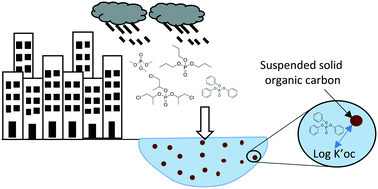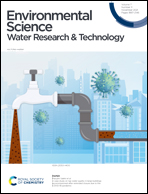Precipitation-induced transport and phase partitioning of organophosphate esters (OPEs) in urban and rural watersheds†
Abstract
Organophosphate esters (OPEs) are extensively used as additives in industrial and consumer products as flame retardants, lubricants, and plasticizers. Such widespread occurrence coupled with precipitation-generated runoff can result in their transport from the atmosphere and terrestrial surfaces into water bodies. Using streamflow samples collected at high temporal resolution from two rivers in the Greater Toronto Area, Canada, we assessed the occurrence, distribution, transport, and likely sources of nine OPEs, covering a wide hydrophobicity range. Chlorinated OPEs (tris(2-chloroethyl) phosphate (TCEP), tris(1-chloro-2-propyl) phosphate (TCIPP) and tris(1,3-dichloro-2-propyl) phosphate (TDCPP)) were prevalent, making up 61% and 68% of total OPEs in the urban and rural rivers, respectively. OPE enrichment at high flow was observed at the outlet of the urban river, primarily due to precipitation-induced transport of particle bound OPEs. OPEs in the low log KOW range like triethyl phosphate (TEP) and TCEP dominated the dissolved phase, while high log KOW compounds like triphenyl phosphate (TPHP) and tris(2-ethylhexyl) phosphate (TEHP) were mostly adsorbed to particles. For OPEs that were sufficiently detected in both phases, calculated organic carbon–water distribution constants ( ) were found to mostly be higher than values predicted using poly-parameter linear free energy relationships (ppLFERs), the open structure–activity/property relationship application (OPERA) and KOCWIN. Predictions made using EPISuite's molecular connectivity index (MCI) method and COSMOtherm were found to be closer to measured values. Particle bound OPEs can (i) sometimes occur at proportions higher than expected based on predicted equilibrium behavior and (ii) be major determinants of OPE occurrence and transport in urban aquatic environments during storm run-off.
) were found to mostly be higher than values predicted using poly-parameter linear free energy relationships (ppLFERs), the open structure–activity/property relationship application (OPERA) and KOCWIN. Predictions made using EPISuite's molecular connectivity index (MCI) method and COSMOtherm were found to be closer to measured values. Particle bound OPEs can (i) sometimes occur at proportions higher than expected based on predicted equilibrium behavior and (ii) be major determinants of OPE occurrence and transport in urban aquatic environments during storm run-off.

- This article is part of the themed collection: Recent Open Access Articles


 Please wait while we load your content...
Please wait while we load your content...